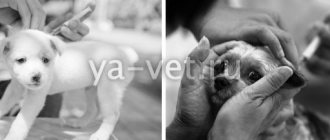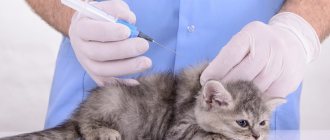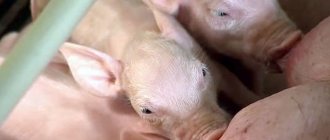Charming giants of the cat world - Maine Coons - give the impression of animals with good health. But for insidious diseases, the breed and size of the pet does not matter. Sooner or later, the owner of the coon is faced with a question about vaccination. When are Maine Coons vaccinated and how to prepare yourself and the animal for this procedure?
Maine Coon vaccinations - pros and cons
To do or not to do, that is the question. Veterinarians and breeders are still arguing about whether cats need vaccinations. It would seem that there is no discussion here, since vaccinations are done for the benefit of the pet:
- Vaccination helps prevent the development of serious diseases in Maine Coons. Some diseases can also affect humans.
- The immune system of the vaccinated animal is enhanced.
- Some vaccines are used not only for prevention purposes, but also for the treatment of infectious diseases.
- Vaccination will cost the owner much less than complex treatment for a sick Maine Coon.
- If an animal’s veterinary passport does not contain vaccination marks, it will not be possible to travel with it on trains or planes.
But some experts and breeders explain their non-acceptance of vaccinations with the following arguments:
- The administered vaccine is effective only in the first months after the injection.
- Vaccination reduces the production of natural immunity in animals.
- Many vaccines contain mercury and other heavy metals that can cause damage to your pet's nervous system and cancer.
How to prepare the house
But before you bring a kitten into your family, make sure that your Maine Coon baby is safe and comfortable in the family. First of all, make sure that the move is not too difficult for your baby. After all, you are tearing him away from his mother and the place to which he is accustomed. To help the baby adapt faster, ask the breeder for the bedding on which he lay. A familiar smell will help him cope with stress faster.
Remove all dangerous objects from his access area: knives, scissors, needles, etc. The kitten is the same child. He really loves to explore the world, but in order for knowledge not to end in tragedy, it is necessary to create conditions for this.
Household appliances, framed photos, vases and other little things also have no place in an apartment where a large kitten lives. He can not only break them, but also injure himself.
There should be no plants in the rooms. Many of them are poisonous to Maine Coon cats. Sweet pea, alpine violet, ivy, azalea, wisteria, mistletoe, laurel, orange - this is not a complete list of plants that are dangerous for the baby.
Hang a special cat net on windows and balconies. Otherwise, curious kittens risk falling down while trying to catch a fly, a bird, or just go for a walk.
To give the kitten something to do and not damage the furniture, buy “cat” toys for him. It would be great if you have a cat house with an observation deck. Kittens love to climb up and look at their “possessions” from above.
It is very important not to leave young kittens alone with children or other pets. The consequences may be unpredictable.
Family members need to be especially attentive and patient during the first weeks while the baby gets used to and adapts.
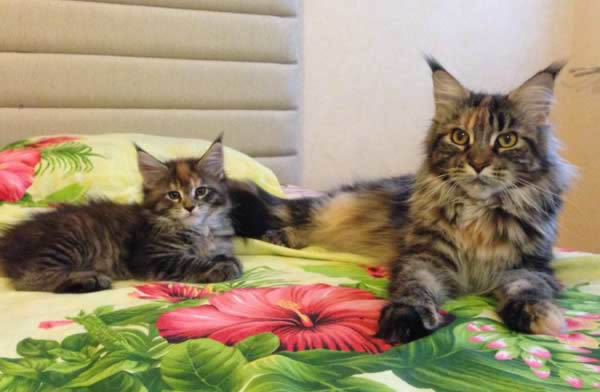
When is vaccination required?
Many owners of Maine Coons and cats of other breeds are sure that if their pet does not go outside, it should not be vaccinated. Veterinarians are rushing to debunk this myth: even an animal that does not leave the walls of its home can become infected with a serious disease.
Some groups of pets are required to be vaccinated. These include:
- Animals that roam freely outside the home. By default, they can come into contact with their homeless brethren.
- Males and cats being prepared for mating.
- Pets that their owners are planning to temporarily rent to a pet hotel.
- Cats that are being prepared to travel abroad or attend exhibitions.
Animals taken from the street must also be vaccinated. Of course, it is difficult to imagine a purebred Maine Coon walking freely along the sidewalks. But if the owner was not sure that his pet had been vaccinated and there is no way to check this fact, it is better to contact a veterinary clinic.
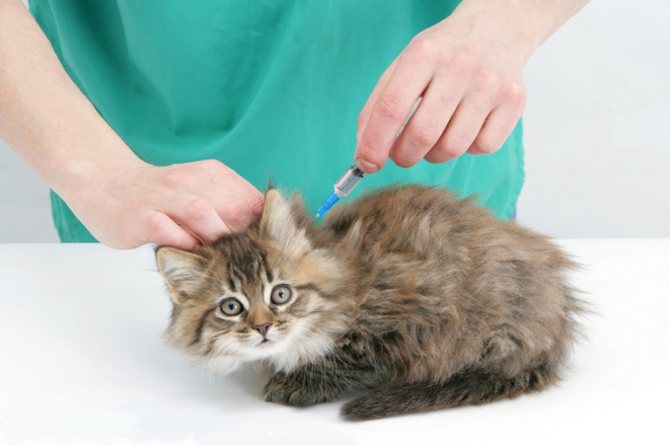
Types of vaccines and diseases
Opponents of vaccination insist that vaccinations are harmful because they weaken the immunity of animals that are supposedly not threatened by any external infection . Experience shows that this opinion is wrong: viruses easily penetrate from the street into an enclosed space, clinging to clothes and shoes. Maine Coons are vaccinated against the most “popular” feline diseases, including panleukopenia, rhinotracheitis, leukemia, calcivirus, chlamydia, herpes and rabies.
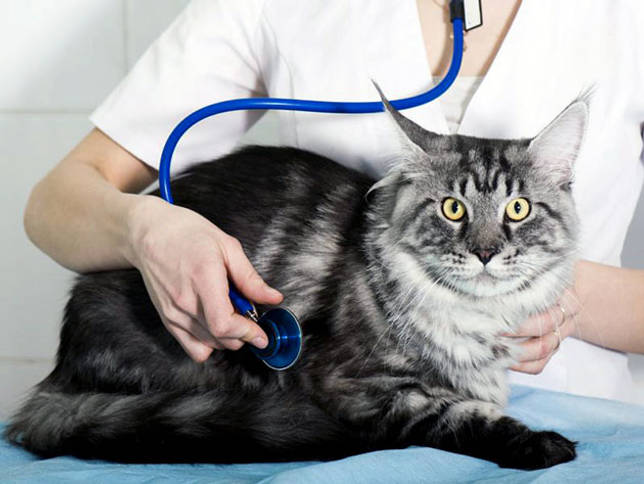
Vaccines
The list of in-demand biological products includes:
- Nobivas Tricat Trio (live) – herpes viral rhinotracheitis, panleukopenia, calcivirosis (Intervet, Holland);
- Nobivac Forcat (live) – panleukopenia, calcevirus infection, chlamydia, viral rhinotracheitis (Intervet, Holland);
- Leucorifelin (combined) – infectious rhinotracheitis, panleukopenia, calcivirosis (Merial, France);
- Fel-O-Vax 4 (inactivated) – panleukopenia, herpes viral rhinotracheitis, chlamydia, calcivirosis (Fort Dodge, USA);
- Quadricate (combined) – panleukopenia, calcivirosis, herpes viral rhinotracheitis, rabies (Merial, France);
- Purevax RCP/RCPCh (combined) – panleukopenia, infectious rhinotracheitis, chlamydia, calcivirosis (Merial, France);
- Multifel 4 (inactivated) – rhinotracheitis, panleukopenia, calcivirosis and chlamydia (Narvak, Russia);
- Polivak-TM/Microderm/Vakderm F – dermatomycosis (Russia);
- Nobivas Rabies (Holland)/Rabisin (France) – inactivated rabies vaccines;
- Purevax FeLV – leukemia (Merial, France); Primucell FIP (live) – viral peritonitis (Merial, France).
Viruses mutate, and some drugs are quickly replaced by others: biologists have to create vaccines that can fight new strains.
Vaccine selection
The owner of the Maine Coon is usually determined not so much by the type of vaccine (live, combined or inactivated), but by the country of origin. The veterinary clinic will always ask whether a domestic or imported drug should be administered to the pet. If you are short on funds, opt for the Russian vaccine; if you are not going to save money, opt for an imported one.
Important! You will also need a foreign drug if you intend to travel with your Maine Coon outside the country. Most countries recognize vaccination carried out exclusively with European drugs. The names of the vaccines, as well as the dates of their administration, must be indicated in the international veterinary passport.
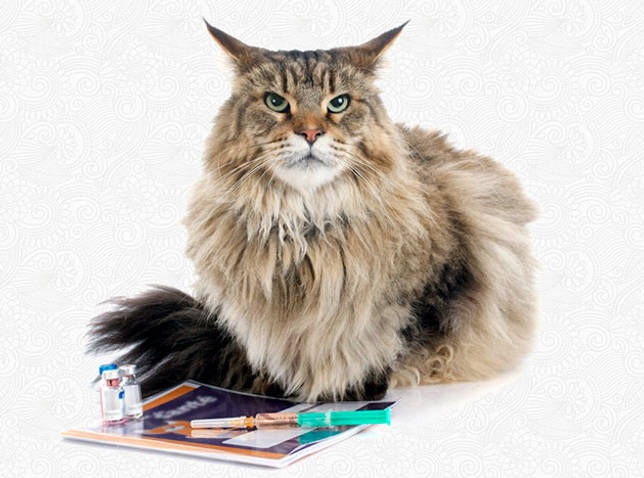
What diseases are Maine Coons vaccinated against?
Modern vaccines contain viruses of certain diseases. They are designed to protect Maine Coons from the most dangerous cat diseases. These include:
- Leukopenia. In common parlance - plague. This disease is very easily transmitted and very difficult for cats to carry. The main signs of the disease: fever, damage to the intestines, nasopharynx, heart.
- Rhinotracheitis. A dangerous disease that quickly “sticks” to cats. The pet becomes passive, lethargic, and discharge oozes from its eyes.
- Calcivirosis. The causative agent of this disease is not sensitive to most used disinfectants. Quickly adapts to the conditions around it. Sick cats experience conjunctivitis, body temperature rises, and the mucous membranes become covered with ulcers.
- Infectious peritonitis. Another common disease in cats, often leading to the death of the animal. Main signs: difficulty breathing, lack of appetite, swollen lymph nodes, fever.
- Leukemia. Viral leukemia is transmitted to a healthy animal after contact with a sick animal. The disease affects the hematopoietic system and increases the cat's susceptibility to infections. Typical signs of viral leukemia: depression, lack of appetite, exhaustion, reproductive dysfunction, enlarged lymph nodes, fever.
- Chlamydia. A highly contagious infectious disease, also called feline chlamydial conjunctivitis. Transmitted by airborne droplets, sexual contact and contact. Main symptoms: discharge from the eyes and nose, shortness of breath, lethargy, loss of appetite, frequent urination.
Vaccination against rabies is mandatory for Maine Coons and other cats. The owner must ensure that the animal receives the appropriate vaccine. After all, a sick pet can infect a person. A domestic cat can become infected with rabies after being bitten by a sick animal. Sometimes, for the saliva of a rabid animal to become infected, it is enough just to come into contact with the area of open wounds or the mucous membrane of a pet’s mouth.
The symptoms of the disease depend on the form of rabies. The most difficult thing to recognize is the atypical form. Signs of this disease resemble gastritis: diarrhea, vomiting, exhaustion. With a mild form of rabies, the cat becomes overly playful, literally intrusive. The owners of a sick pet may think that it is choking, but in fact this is how paralysis of the pharynx occurs. In the violent form of rabies, the cat becomes lethargic and aloof, tries to eat inedible objects, gnaw and lick the bite site through which the rabies virus entered.
Get vaccinated!
Only completely healthy coons can be vaccinated. Therefore, before vaccination, the doctor carefully examines your pet and measures its body temperature. When choosing a vaccination schedule for your kitten, your veterinarian must take into account the condition of the kitten and the circumstances of its acquisition. It is prohibited to vaccinate:
- kittens under 2 months of age;
- cats in heat, pregnant and lactating;
- weakened and sick animals.
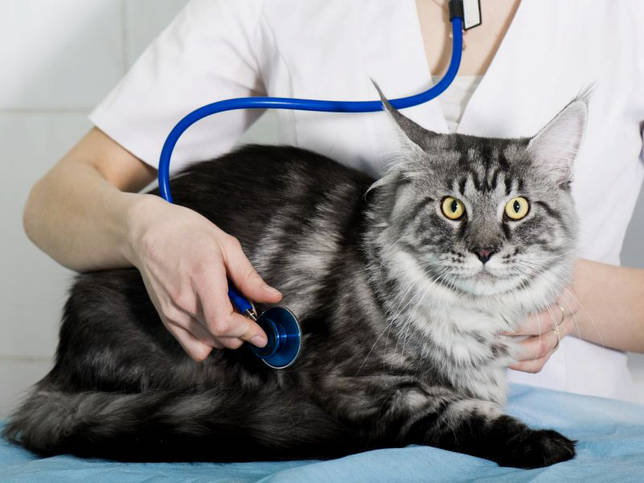
How the vaccine works
Vaccination helps produce antibodies that work against the disease. The administered vaccine “models” infection. For this purpose, live weakened, neutralized viruses or only their particles, toxoids, and protein associated with virus components can be used.
The special composition of the vaccine does not cause disease, but at the same time awakens the body's defenses. Trained by training, the body's brave immune cells - T-lymphocytes - after exposure to the vaccine, know how to fight the disease and will not allow it in the future.
First vaccination
The first vaccination of cats at two months is comprehensive. It creates protection against rhinotracheitis, panleukopenia, calicivirus and feline chlamydia. After three weeks, revaccination is carried out with the same vaccine, due to which lasting immunity to these diseases is developed within 2 weeks. Since the kitten’s body is slightly weakened in the process of producing antibodies to infections, it is recommended not to contact other animals at this time.
If the first Maine vaccination was not carried out at 2-3 months, it is recommended to wait a little and try to vaccinate your furry pet after 6 months. By this time, the kitten’s body has already become sufficiently strengthened, and revaccination is not required. In the future, it is necessary to vaccinate once a year.
Rabies vaccination
Often, along with revaccination at 3 months, the kitten is vaccinated against rabies. This vaccination is mandatory and is given free of charge every year. Some experts note that Maine Coons over a year old should be vaccinated against rabies, and trips to nature should be limited until that time.
All vaccines are updated regularly. Their creators are trying to take into account new emerging strains of viruses. Together with your veterinarian, you can choose a domestic or imported vaccination that is most suitable for your pet.
Features of vaccination of Maine Coons
Before vaccinating the charming giant Maine Coons, it is useful to familiarize yourself with the list of vaccines offered by veterinary clinics and the features of their use.
Types of vaccines
There are two main types of vaccines for cats:
- Alive. They include viral agents of the disease, only slightly weakened. Such viruses are no longer capable of developing the disease, but they force the body to produce appropriate antibodies.
- Dead (synthetic). Laboratory-derived vaccines. They contain dead cells similar to disease viruses. These cells are safe for the animal and cause an appropriate immune response. Such vaccines have a weaker effect compared to live strains of the disease, but are easier to tolerate in animals.
Modern vaccines are practically safe for Maine Coons and do not cause side effects. Of course, provided that the pet is healthy.
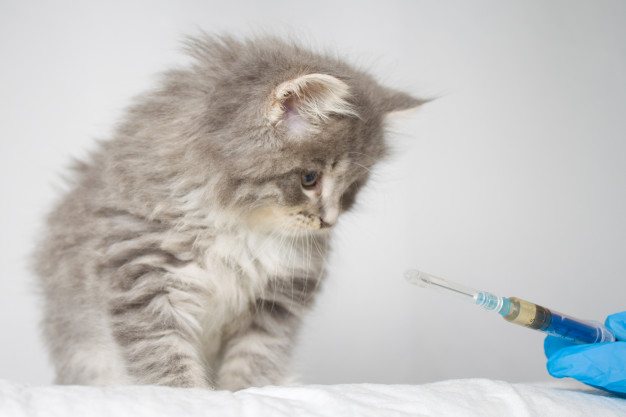
Another stumbling block in the selection of vaccines is the purchase of imported or domestic products. Modern veterinarians offer several developments for domestic cats:
- Multifel 4. It is considered one of the most effective Russian-made drugs. It creates lasting immunity. The vaccine is used to form an immune barrier against the most common cat diseases: panleukopenia, rhinotracheitis, calicivirus and chlamydia. Some experts consider one of the disadvantages of Multifel 4 to be the possibility of pet allergies and the absence of rhinotracheitis viruses in its composition.
- Nobivac - Tricat. Imported live vaccine. Contains weakened leukemia, chlamydia, rhinotracheitis and panleukopenia viruses. Nobivac - Tricat should be used with caution in debilitated cats. After vaccination, a deterioration in the animal’s condition is often observed.
- Felovax. A vaccine containing dead viruses, safe for Maine Coons. The drug contains weakened viruses of the four most common feline diseases: panleukopenia, rhinotracheitis, calicivirus and chlamydia.
- Quadrocket. Russian-made vaccine. Includes rabies, panleukopenia, herpes and calcivirosis viruses.
- Purevax. Helps to form stable immunity in Maine Coons to panleukopenia, infectious rhinotracheitis, calcivirus and chlamydia within two weeks after vaccination. The main contraindication to the use of Purevax is individual intolerance to the components of the vaccine.
- Microderm. The action of this live vaccine is aimed at combating lichen infection. Interestingly, the product has a healing effect. That is, with its help you can cure an already infected cat.
Many vaccines are combination vaccines. They include weakened strains of several diseases, for example, rhinotracheitis and calcivirosis. This approach is very convenient, because the animal receives two injections at a time, and not three or four.
Methods of administering the vaccine
The speed of action of the drug and the degree of subsequent protection depend on how the vaccine was administered. Any vaccination should be carried out taking into account the recommendations of the veterinarian or the manufacturer.
Thus, vaccines containing feline panleukopenia virus are administered subcutaneously or intramuscularly. Some vaccines (against peritonitis) are administered intranasally, in other words, as drops in the nose.
Preparing for vaccination
The owner of a Maine Coon can minimize the risk of developing side effects after vaccination. To do this, just follow a few simple preparatory steps:
- Make sure that the coon is absolutely healthy before vaccination.
- Ask your veterinarian what vaccines are available.
- If necessary, you can purchase an alternative to the vaccine offered by the clinic. The product is stored under suitable conditions.
- Purchase only modern vaccines.
- Two weeks before vaccination, the Maine Coon should be dewormed, that is, dewormed. Parasites reduce the body's immune strength.
Maine Coon vaccination schedule
Maine Coon vaccinations begin at a very tender age - 2-3 months. But the introduction of the first vaccine does not make sense without repeated revaccination. Next, the vaccine is given to prevent diseases at certain intervals.
Table: Maine Coon vaccination schedule
| Vaccine name | First vaccination | Revaccination | Subsequent vaccination |
| Panleukopenia | 8-12 weeks | After 2-3 weeks | Annually |
| Trichophytosis and microsporia | 8 weeks | 10 weeks | Annually |
| Rhinotracheitis | 8-12 weeks | After 2-3 weeks | Annually |
| Chlamydia | 10-12 weeks | After 2-4 weeks | Annually |
| Infectious peritonitis | 16 weeks | After 4 weeks | Annually |
| Rabies | 8-12 weeks | — | Once every 1-3 years (depending on the vaccine). |
| Calcivirosis | 8-12 weeks | After 2-3 weeks | Annually |
What to vaccinate with?
There are two types of vaccines - “live” and “dead”.
Live vaccines contain a weakened live virus. Live vaccines are prepared from apathogenic pathogens weakened under artificial or natural conditions. Viruses lose their pathogenic properties and lose the ability to cause infectious diseases, but retain the ability to reproduce. An infection artificially caused by the introduction of a vaccine continues for a certain time, is not accompanied by a clinical picture of the disease and stimulates the formation of immunity to pathogenic strains of microorganisms.
Live vaccines create longer-lasting and stronger immunity than inactivated (dead) vaccines.
When using live vaccines, keep the following points in mind:
- Spontaneous mutations. During the multiplication of the virus in the cat’s body, unpredictable changes in the genetic structure and the return of virulence (pathogenicity) of a given microorganism are possible. In this case, the cat will get really sick.
- Coinfection (joint infection) with a “wild” virus. Simultaneous infection with a vaccine virus and a wild one is very dangerous, although unlikely.
- If the cat's immune system is weakened, vaccination may lead to the development of the disease.
Due to the fact that live vaccines are made on the basis of living microorganisms, a number of requirements must be observed to ensure the preservation of the viability of microorganisms:
- live vaccines should be stored and transported at a temperature of 4-8 ° C;
- freezing live vaccines does not affect their properties;
- live vaccines quickly lose their immunogenic properties at room temperature;
- loss of vacuum (violation of the integrity of the ampoules) can lead to the death of the drug.
Inactivated (dead) vaccines contain the entire microorganism that has been killed. Viruses are killed by physical (temperature, radiation, ultraviolet light) or chemical (alcohol, formaldehyde) methods.
For “dead” vaccines, immunity begins to develop immediately after administration, for “live” vaccines - on the 6-7th day: in the first days, viruses actively multiply, and only then an immune response begins to develop.
“Dead” vaccines are not able to multiply in the body: immunity is developed from the small number of killed microbial bodies (or their fragments) that are introduced. In this regard, dead vaccines are safe - they cannot lead to the development of a viral disease. But at the same time they cause less effective and long-lasting immunity.
The safety of dead vaccines can also be questioned: chemicals added to boost immunity can cause serious adverse reactions and complications in the liver and/or kidneys.
The question of the comparative safety and effectiveness of “live” and “dead” vaccines remains open.
The next vaccination is carried out when the kitten is one year old, it includes a comprehensive vaccination and a rabies vaccination. Then every year you need to repeat these two vaccinations without revaccination. In this case, the animal will be protected from all common infections.
- The mandatory list includes vaccines against panleukopenia, calicivirus, rhinotracheitis and rabies. Rabies vaccination is always given separately, other infections are vaccinated with a polyvaccine;
- The list of recommended vaccinations includes the fairly common chlamydia and leukemia.
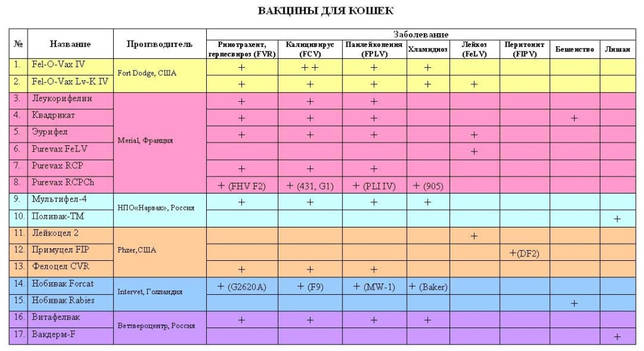
This is interesting: How many years do Maine Coons live at home?
What to do after vaccination
After vaccination and revaccination, the Maine Coon needs to be quarantined. The latter is necessary so that the animal that has been vaccinated has time to develop antibodies to the disease. While in quarantine, the Maine Coon should not go outside or have contact with other animals.
An isolated pet needs to be fed well and provided with rest. It is better to discuss the specific diet during this period with your veterinarian.
The exact period of isolation depends on the type of vaccination and the general condition of the kitten or adult. The more complex the vaccine (it protects against more diseases), the more difficult it is for the cat’s body to produce antibodies. Consequently, the pet needs more time to adapt.
The average isolation period is 7-14 days. The exception is the rabies vaccination. After it, the Maine Coon must be in quarantine for at least 30 days.
Advantages and disadvantages
Since there are many positive factors of vaccination, breeders rarely pay attention to the negative ones. But only by comparing them for himself, the owner can decide whether to vaccinate or not. The first factor is age. If the kitten feeds on mother's milk, due to its composition, the little Maine Coon is provided with immunity. But by switching to a different type of food, the pet becomes more vulnerable to infections, and having been vaccinated before 16 weeks, the antibodies in the milk prevent the formation of its own immunity. The risk of infection should also be taken into account. How much time does the baby spend outside and in contact with other animals, what is the percentage of infection in a particular region. An important factor is the severity of the disease, while herpes does not pose any serious threat, rabies can become fatal.
Thanks to vaccination, it was possible to reduce the spread of the feline and canine distemper virus and the number of cases of rabies. In the 60s of the last century, the development of an epidemic of viral rhinotracheitis in cats was stopped.
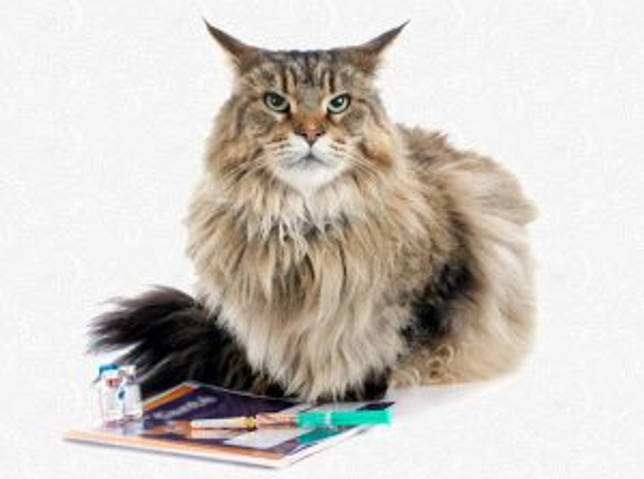
Some vaccines are not very effective in producing immunity and may also increase the risk of developing sarcoma. Vaccination is not carried out once and for life, so it is worth carrying out several times. Vaccinations differ from each other not only in price, but also in quality. They can be tolerated differently by animals; after some, the pet may walk lethargic and sleepy for 3 days, and some will not provide protection to the kitten at all and it may get sick.
Possible complications after vaccination
After administering the vaccine, the owner should observe the animals for a week. During this period, a number of signs and symptoms may appear that are the result of an allergy to the biocomponents of the drug. The most common side effects from the vaccine are:
- inflammation of the skin at the injection site;
- diarrhea and vomiting;
- apathetic state.
Important. If the Owner has observed at least one of these symptoms in the cat, the animal should be immediately shown to a veterinarian.
Possible complications and consequences
These tips will be useful for those who are planning to vaccinate a cat on their own. First, you need to preserve the active properties of the vaccine, so along with it, buy ice in a package intended for transporting medications.
During transportation, do not allow sunlight to reach the vaccine, and after delivering it home, store it according to the instructions . By violating the storage conditions, you will negate the entire effect of the vaccination. Use a disposable (sterile) syringe, releasing excess air from it before the injection: where to administer the vaccine, intramuscularly or subcutaneously, is indicated in the instructions.
Even if this is not the first vaccination that you do yourself, stock up on antihistamines (diphenhydramine, suprastin, tavegil) and glucocorticoids (dexamethasone, prednisolone) in advance. They will help save the Maine Coon from anaphylactic shock, which, although rare, is very dangerous. The cat has the following symptoms:
- general weakness;
- swelling (especially dangerous in the larynx area, as it leads to suffocation);
- shortness of breath and cramps;
- nausea and vomiting;
- involuntary urination/defecation.
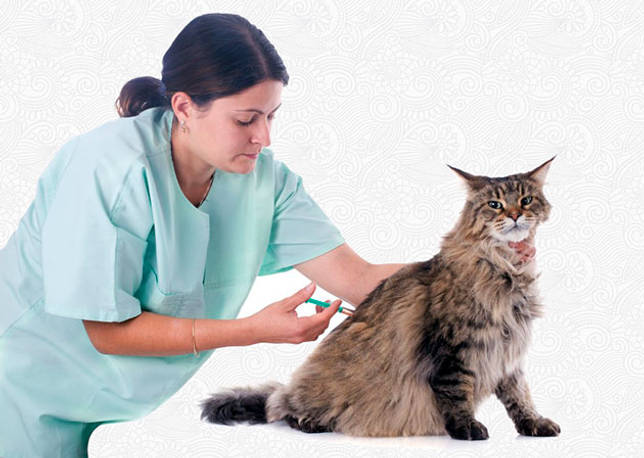
When anaphylactic shock occurs:
- put ice on the injection site and pull it higher with a tourniquet;
- administer prednisolone (0.3–0.6 ml/kg) or diphenhydramine (0.1–0.3 ml/kg) intramuscularly.
And urgently call the doctor, whose number should always be at hand.
Arrival at a new home:
When you bring a kitten home, at first limit its habitat to only one room (for example, one room or kitchen). The room you choose should not have upholstered furniture, drafts,
cracks, holes into which a kitten can climb and not get out on its own. At first, his litter tray and bowls of food and water should be placed in this room. Let the kitten get used to the new place and explore its territory. If he doesn't make contact, leave him alone, let him get used to it, be patient. Sooner or later he will want to eat and cuddle and will come out to you. Usually this period lasts 2-3 days, after a week the kitten will be completely comfortable. Also, do not be alarmed that the kitten may not go to the toilet for several days, usually up to three days, this is normal. We lock up the kitten for the reason that he first gets used to the smell, to the new room and to you and does not lose the toilet. Your apartment is a huge new space for him and he might just get lost. Example: we put a small child in the center of Mega and tell him to find a toilet... the same goes for a kitten, so if you decide to take him into your bed for the first time, don’t be surprised that he can
just write there)))
After 2-3 days, you can open the doors and let the kitten out to get acquainted with the new possessions, placing the tray and food dishes in their permanent place. Next, introduce the kitten to the litter box (several times a day, place
kitten into it), do the same with bowls (bring them several times a day).
When you arrive home, pay more attention to the kitten and its acclimatization will go faster.
I’ll give you some used scent filler with me, which you need to pour into your baby’s tray when you get home.
DANGERS TO THE KITTEN:
Do not give your kitten plastic bags, needles, strings, balls, or spools to play with. New Year's tree rain and tinsel are very dangerous for all cats. For inexplicable reasons, all cats love to chew Christmas tree decorations, and the matter often ends with an urgent visit to the veterinarian, and in some especially severe cases, with the death of the animal.
WINDOW
There should be screens on the windows in rooms that the kitten has access to. Coons can't fly! And unfortunately, falling even from the second floor most often ends in death. Do not let the kitten out onto an open balcony that is not protected by special nets. Do not forget that your pet is a predator, and a bird flying by can make its hunter instinct activate, before which the instinct of self-preservation may temporarily recede. There are special nets called Anti-Cat that are made to order for your windows.
There are many of them on the Internet and you can choose the best one for you. Vertical ventilation is a huge danger for a kitten; it can get stuck and die a painful death. There are special protective
window covers for protection during vertical ventilation.
DOORS
Doors, whether regular or sliding, also pose a danger to both kittens and adult cats. They can seriously injure the animal, even breaking the spine. After this the cat
may not be able to walk. Therefore, as soon as a tailed friend appears in your house, everyone should immediately be given a signal to close the doors smoothly, after first checking to see if the cat is nearby.
PLATE
Cats can't always recognize what's hot from a distance. In theory, their mustache should help them with this, but this is not always the case. For example, if a cat decides to jump onto a tile from a distance, he may not
sense the temperature. Try to close the kitchen when you are cooking.
FIRE
Any open fire is a threat to a cat. Candles, fireplace, hotplate, etc. places must be reliably protected from the new occupant. If you think he senses the temperature of the fire, you are mistaken.
IRON
As we have already said, a cat is not always able to determine from a distance what is hot and what is not. Therefore, it may not recognize the iron. Use this device and immediately place it out of reach to cool down.
WIRES
One of the most dangerous injuries for a cat, and one of the most real, is electric shock. Cats love to chew on wires, especially when they are teething. Therefore, they need to be hidden or sealed with double-sided tape. You can put the wires in special protective tubes.
WASHING MACHINE
The first thing you need to take care of is that from now on, everyone in the household checks where the kitten is before starting the washing machine. And they didn’t let him in there at all. As soon as you have dried the machine after use, close it immediately. Do you put dirty things there for storage? Do this and immediately close the door.
Let the cat not form the habit of resting in the drum. Be very careful because dying in a washing machine is a terrible death.
HOUSEHOLD CHEMICALS
Any household chemicals can be dangerous for a kitten. Of course, you think that he is not such a fool to drink bleach or something like that. Yes, not like that. But he can easily accidentally smear himself in it, after which he will definitely want to lick himself clean. And then poisoning awaits him. Possibly terrible poisoning. Or even a burn. So all household chemicals should now be locked up. In the literal sense of the word. Select a special shelf with a door in the closet for them.
TRASH BIN
Many cats love to climb into the trash can and check what is there. They might eat something and get poisoned.
MEDICINES
Almost all human medications are very dangerous for cats, even fatal. Now you will have to eradicate the habit of leaving blisters and bottles anywhere. After all, an animal can chew through the packaging and eat what it shouldn’t.
UNSTABLE ITEMS
Any unstable object is a potential injury. If it is heavy and falls from above, it can easily
kill your pet. If it is unstable, high and falls when the cat is sitting on it, the animal may also be injured. Secure anything that is loose.
PLANTS
Among domestic flowers, there are also those that are considered poisonous. But this does not at all prevent the tailed ones from feasting on them. In almost 100% of cases, the presence of cats and flowers in the house are incompatible at the same time. Do you want both? Prevent the kitten from having access to plants.
OTHER ANIMALS AND CHILDREN
Old residents of the apartment, such as dogs, other cats, birds or even children, also pose a danger to the new resident.
Therefore, in the first days it is advisable to isolate him from them. And the acquaintance should take place in front of you: during the first days, you should leave your pets and your children alone with the cat only under supervision. Next you need to observe how they treat each other. After all, as soon as you leave the threshold, they can fight. Therefore, during your absence, animals should be placed in different rooms.
KITTEN FOOD:
The animal should be fed with food or canned food of super premium class or higher! In our nursery, all animals eat dry MONGE Cat Kitten. Kittens up to one year old must be fed baby food (i.e., kitten food). In addition to dry food, you can feed your kitten any protein products, carbohydrates are excluded!!! I will give you some food with me for the first days. If over time you decide to switch your kitten to another dry food, the transition should be gradual. It should be added to your regular food within a week.
a little new. You should start with a few pellets, and by the end of the week all the food may be new. It is important that the transition to food that is convenient for you does not harm the kitten and is not abrupt.
Our kittens' main diet is dry food.
We give other protein foods as treats, and not every day.
For example: 2-3 times a week a little (50-100g) beef or meat mix (pre-frozen for 7-10 days and thawed at room temperature). 1-2 times a week cottage cheese 9-18% fat. 1-2 times a week kefir or fermented baked milk. Sometimes you can indulge in cream with no more than 10% fat content. Sometimes you can give a fresh quail egg (no more than 2 pieces per week). You need to understand that each kitten is individual, some love one thing, and some another.
I recommend not to get carried away with natural food, because over time the kitten may refuse dry food, and it is very difficult to properly balance natural food.
You can make a meat mix or “Kuno-Kashka”, they are healthier and more balanced.
There are many recipes, here is one of the simplest:
— Chicken necks ‒ 30%
— Chicken heart (pork or turkey) ‒ 20%
— Chicken gizzards ‒ 20%
— Chicken (or turkey, rabbit, beef) thigh pulp or fillet - 30%
We cut the necks into several parts (3-5 depending on the size of the neck), you cannot beat the necks, because when beating, fragments may form and they will injure the esophagus. Better cut it smaller. Cut the chicken heart into 2-3 parts. Cut the chicken gizzards into 5-6 pieces. Cut the pulp into pieces of approximately 1*1 cm, or strips 1*2 cm. Mix everything, package it in bags (about 100 grams per feeding), and put it in the freezer for 5-7 days. Then we take it out, defrost it at room temperature, and give it to the kitten. It is better to separate feeding dry food and meat. It's easy to do. In the morning, just before leaving for work, you take out the meat to defrost, come back in the evening and give it to the kitten. Most likely, the kitten was sleeping before your arrival and therefore did not eat dry food.
CHICKEN NECKS are an excellent source of calcium and many other beneficial microelements. There is a lot of useful cartilage tissue in the necks. They clean teeth well when chewing, train the jaws and promote withdrawal.
wool from the stomach.
HEART Chicken, turkey, pork (better digestible). One of the most useful products for Maine Coons. The main source of taurine, rich in potassium, magnesium, phosphorus, zinc. Contains vitamins A, E, K, R.V.
CHICKEN AND TURKEY STOMACH is a source of muscle and connective tissue, an excellent source of digestive enzymes.
MEAT: beef, chicken, turkey, lamb, rabbit, venison, horse meat. Beef is best suited for stringy meat, trimmings from the inside of the ribs, trimmings from heads, flank - this is meat from the abdominal part of a large carcass
cattle, it is the most juicy, dense and clean, without bones. We milk red meat (drumstick, thigh) without skin from a chicken carcass. Chicken breasts are low in calories and have no special nutritional value - they are suitable for cats
obesity. And for a healthy cat, red meat is better.
An example of protein foods that can sometimes be given to cats:
Chicken or turkey fillet, any beef or poultry by-products - liver, heart, stomach, lean beef, lamb, rabbit, low-fat varieties of boneless ocean fish (navaga, cod, haddock - maximum 1 time per
week, it is not recommended to give fish to cats), fatty fish without bones (salmon, trout - also no more than once a week to cover the need for fatty polyunsaturated acids Omega-3 and Omega-6), boiled shrimp.
Never feed any pork products.
Forbidden foods also include: fatty, salty, sweet, smoked (herring, smoked sausage, frankfurters, sausages). Eliminate carbohydrates! Raw meat products are the most beneficial for cats, however, in order to
To minimize the possibility of infection, meat should first be subjected to low-temperature treatment, in other words, frozen for 10-14 days, do not serve fresh or fresh. If you feed
You don’t need to give your kitten any vitamins with dry food!
Water: Water can be filtered or offered from the tap.
The water should be changed several times a day and the bowl should be washed.
Litter: Our kittens are accustomed to clumping bentanite litter Pi-pi-bent and VAN CAT.
If you want to transfer the animal to another litter, it is advisable to do this after acclimatization in your home and gradually. If you decide to change the filler, this is done like this: leave the base
filler of your choice, and sprinkle the top layer with the usual (clumping filler), gradually removing it completely from the tray.
Scratching post and nail trimming: The kitten must have a scratching post. All babies are accustomed to sharpening their claws.
If the nails are long and bothering you or the animal, you can trim them. You can buy a nail clipper at a pet store.
If you want to purchase a complex, then it must be stable, with shelves. You can also hang wall shelves; cats love to sit on top and watch what is happening.
Ears: Ears are best cleaned with wet wipes specially designed for this purpose. They can be bought at any pet store. But you can use regular wet wipes.
Washing: Washing the animal is recommended as needed. Do not overuse washing.
For washing, use only professional shampoos: Groomers Goop, Jerob, Pet Silk.
Vaccinations: Vaccinations are given once a year. The next vaccination is given one year after the date of the last vaccination, which is indicated in the veterinary passport. Further, throughout life, the vaccine is given once a year.
Before vaccination, the kitten must be dewormed by weight with Canikquantel or Milbemax 10-14 days before vaccination. If an animal eats meat and offal, it is advisable to deworm it every six months.
drug Kanikquantel by weight. Fleas must be treated in the off-season (spring, autumn) with Frontline, Advantage or Stronghold.
Everything you need for a kitten:
Tray: Preferably the largest one with high sides or a house (we remove the door of the house). The largest tray size on the market at the moment is 57*45*48
Bowls: ceramic (for treats), large metal (for dogs) for dry food and water. It is also good to use a glass bowl for water (a large salad bowl made of thick glass will do). The water bowl must be stable. because Many Coons love to rake water with their paws and can turn the bowl over.
Carrying: whatever is comfortable for you, but preferably in a large size (for growth). Ideally, a rigid carrier (for example, “CAYMAN”).
Puffer: Soft, large or medium size (without droplets on the teeth). It's not a bad idea to have a comb with rotating teeth. You need to learn to itch and trim your nails from childhood. You need to scratch at least 1-2 times per
week. Scratch the tail with caution, without combing it too much, as the tail takes a long time to grow overgrown.
Toys: No feathers! Any, very good toys from Peg Stages (there are various toys with catnip, balls and interactive toys (tracks), there are ordinary rattling balls and mice that are sold in any pet store and which all kittens love without exception.
If you have any questions or problems in the future, please do not hesitate to write or call! We remember and love every baby born to us!
Conclusions about the breed
Once in the house, the cat rightfully becomes the eminence grise in it, and establishes a tandem with the owner, full of mutual understanding and love.

